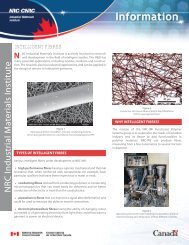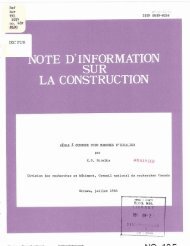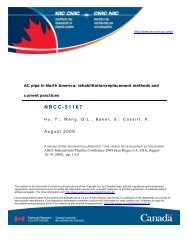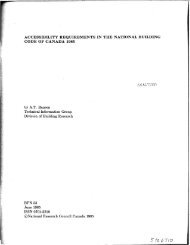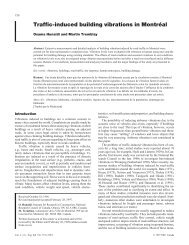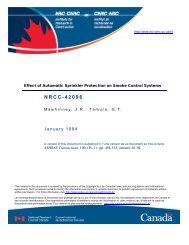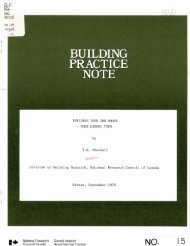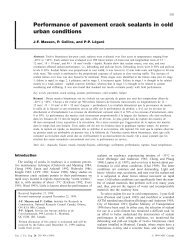New facility to determine fire resistance of columns - National ...
New facility to determine fire resistance of columns - National ...
New facility to determine fire resistance of columns - National ...
- No tags were found...
Create successful ePaper yourself
Turn your PDF publications into a flip-book with our unique Google optimized e-Paper software.
+SerTH1 I CouncilN21dno. 914cop. 2Nat~onal Research Conseil nationalCanada de recherche CanadaNEW FACILITY TO DETERMINE FIRE RESISTANCEOF COLUMNSby T. T. LieANALYZEDReprinted fromCanadian Journal <strong>of</strong> Civil EngineeringVol. 7, No. 3, September 1980pp. 551-558NRC - ClSTlBLDG. RES.LIBR k2YDBR Paper No. 914Division <strong>of</strong> Building ResearchPrice $1.00OTTAWA NRCC 18423
This publication is being distributed by the Division <strong>of</strong> BuildingResearch <strong>of</strong> the <strong>National</strong> Research Council <strong>of</strong> Canada. Itshould not be reproduced in whole or in part without permission<strong>of</strong> the original publisher. The Division would be glad <strong>to</strong> be<strong>of</strong> assistance in obtaining such permission.Publications <strong>of</strong> the Division may be obtained by mailing theappropriate remittance (a Bank, Express, or Post Office MoneyOrder, or a cheque, made payable <strong>to</strong> the Receiver General <strong>of</strong>Canada, credit NRC) <strong>to</strong> the <strong>National</strong> Research Council <strong>of</strong>Canada, Ottawa. KIA 0R6. Stamps are not acceptable.A list <strong>of</strong> all publications <strong>of</strong> the Division is available and may beobtained from the Publications Section, Division <strong>of</strong> BuildingResearch, <strong>National</strong> Research Council <strong>of</strong> Canada, Ottawa.KIA 0R6.
I<strong>New</strong> <strong>facility</strong> <strong>to</strong> <strong>determine</strong> <strong>fire</strong> <strong>resistance</strong> <strong>of</strong> <strong>columns</strong>T. T. LIEFire Research Section, Division <strong>of</strong> Building Research, <strong>National</strong> Research Council <strong>of</strong> Canada, Ottawa, Ont., Canada KIA OR6Received February 11, 1980Accepted March 27, 1980The new Division <strong>of</strong> Building Research (DBR) column testing furnace is described and an doutline given <strong>of</strong> the proposed studies that this <strong>facility</strong> makes possible.Le four de mise a I'essai des poteaux de la Division des recherches en bkiment (DRB) est decritet les differentes etudes que cette installation peut permettre sont enumirees.Can. J. Civ. Eng., 7,551-558 (1980)0315- 1468/80/030551-08$01.00/0@I980 <strong>National</strong> Research Council <strong>of</strong> Canada/Conseil national de recherches du Canada6 22 2--"!5- gJ
552 CAN. J. CIV. E LNG. VOL. 7, 1980IntroductionOne <strong>of</strong> the safety requirements for buildings <strong>to</strong>dayis the provision <strong>of</strong> appropriate <strong>fire</strong> <strong>resistance</strong>. Untilfairly recently, the <strong>fire</strong> <strong>resistance</strong> <strong>of</strong> building componentscould only be <strong>determine</strong>d by costly andtime-consuming tests. Now it can be <strong>determine</strong>d bycalculation, thanks <strong>to</strong> the development <strong>of</strong> mathematicalmodels. Because these models only partiallyrepresent reality, however, their validity must beverified.A versatile column testing furnace has recentlybeen installed at the Division <strong>of</strong> Building Research<strong>of</strong> the <strong>National</strong> Research Council <strong>of</strong> Canada. Thenew <strong>facility</strong> will enable the Division <strong>to</strong> test thevalidity <strong>of</strong> mathematical models <strong>to</strong> predict <strong>fire</strong><strong>resistance</strong>, and <strong>to</strong> obtain a better understanding <strong>of</strong>the many problems for which there are yet notheoretical solutions. Although designed for researchpurposes, the furnace is also capable <strong>of</strong> performingstandard tests on specimens in accordance with mostinternational standards.Calculation ProcedurePredicting the <strong>fire</strong> behaviour <strong>of</strong> structural membersinvolves the specification <strong>of</strong> <strong>fire</strong> temperatures and thecalculation <strong>of</strong> temperatures, deformations, andstrength <strong>of</strong> structural members. Because all thesequantities vary with time the calculation procedureis complex, but it has been simplified by the developmen<strong>to</strong>f numerical calculation techniques and the use<strong>of</strong> high-speed computers. The various steps incalculating the <strong>fire</strong> <strong>resistance</strong> <strong>of</strong> a member and determiningthe appropriate protection are shown inFig. 1.Fire LoadFirst is the determination <strong>of</strong> the <strong>fire</strong> load, i.e., thecombustible contents, which should form the basisfor the <strong>fire</strong> <strong>resistance</strong> design <strong>of</strong> a building. Severalsurveys have been carried out recently <strong>to</strong> obtaininformation on <strong>fire</strong> loads in buildings (Bryl et al.1974; <strong>National</strong> Academy <strong>of</strong> Sciences 1977).Fire TemperatureAssuming that the design <strong>fire</strong> load is known, thenext step is <strong>to</strong> <strong>determine</strong> time-dependence <strong>of</strong> the <strong>fire</strong>temperature. Calculation <strong>of</strong> the <strong>fire</strong> temperaturecourse <strong>of</strong> compartment <strong>fire</strong>s has been the subject <strong>of</strong>several studies (Kawagoe and Sekine 1963; odeen1963 ; Magnusson and Thelandersson 1970; Tsuchiyaand Sumi 1971; Harmathy 1972). The <strong>fire</strong> temperaturecourse can be <strong>determine</strong>d from a heat balancefor the compartment, taking in<strong>to</strong> account the heatproduced and the heat losses <strong>to</strong> walls and openings.The most important fac<strong>to</strong>rs are <strong>fire</strong> load and thedimensions <strong>of</strong> the openings through which air,IDETERMINATIONOFDESIGN FIRE LOADICALCULATION OFFlRE TEMPERATURE CURVEr+=7PROPOSED PROTECTION1CALCULATION OFTEMPERATURES OF STRUCTUREMODIFYPROTECTIONrl,CALCULATION OF STRENGTHOF STRUCTURE DURING FlREFro. 1. Calculation procedure for <strong>fire</strong>-resistant design.necessary for combustion <strong>of</strong> the <strong>fire</strong> load, can enter.How <strong>fire</strong> load affects <strong>fire</strong> temperature is shown inFig. 2, the influence <strong>of</strong> openings in Fig. 3. Fire load<strong>determine</strong>s the duration <strong>of</strong> the <strong>fire</strong>, whereas theopenings influence both intensity and duration. Thecalculated <strong>fire</strong> temperature course or, eventually, astandard <strong>fire</strong> temperature curve is used as exposuretemperatures for the calculation <strong>of</strong> the temperaturesin structural members.Temperature <strong>of</strong> MembersTemperatures <strong>of</strong> <strong>fire</strong>-exposed structural members 4can be calculated; the most common procedures arethe finite difference and finite element methods. Inthese, the dependence <strong>of</strong> material properties ontemperature is taken in<strong>to</strong> account and, in some cases,a high accuracy can be obtained. For example, theaccuracy with which temperatures in protected steelcan be predicted is better than 1% if the materialproperties <strong>of</strong> the protection are known precisely(Lie 1977). In practice this is usually not the case, butan accuracy <strong>of</strong> 15-20% is possible, which in the field<strong>of</strong> <strong>fire</strong> is regarded as fairly accurate.Although, in principle, it should be possible <strong>to</strong>I
TIME, hFIG. 2. Influence <strong>of</strong> <strong>fire</strong> load on <strong>fire</strong> temperature course.obtain for concrete the same accuracy as for steel, it* is in fact more difficult <strong>to</strong> predict concrete temperatures.The main reason is that the thermal properties<strong>of</strong> concrete depend strongly on the properties <strong>of</strong> theaggregate, which may vary over a wide range andare difficult <strong>to</strong> <strong>determine</strong> accurately. In addition,moisture in concrete will have considerable influenceon its internal temperatures.,Strength <strong>of</strong> MembersWhen the temperature rises in <strong>fire</strong>-exposedmembers, their strength lessens. If the <strong>fire</strong> load issufficient and the duration <strong>of</strong> the <strong>fire</strong> long enough,a stage will be reached at which the strength <strong>of</strong> themember will no longer be adequate <strong>to</strong> support thestructural load. The <strong>fire</strong> load that is just sufficient <strong>to</strong>reduce the strength <strong>to</strong> this critical point is definedas the critical <strong>fire</strong> load. The aim is <strong>to</strong> make the critical<strong>fire</strong> load for a member sufficiently high <strong>to</strong> allow it <strong>to</strong>withstand the burn-out <strong>of</strong> the design <strong>fire</strong> load. Ingeneral, this can be achieved by selecting for themember appropriate protective materials <strong>of</strong> adequatethickness and appropriate dimensions.Test FurnaceThe test furnace was designed so that it couldproduce the conditions <strong>to</strong> which a member might beexposed during a <strong>fire</strong>, such as <strong>fire</strong> temperatures,structural loads, and heat transfer. It consists <strong>of</strong> asteel framework supported by four <strong>columns</strong> with thefurnace chamber inside the framework (Fig. 4;Table 1 gives details <strong>of</strong> furnace characteristics).Loading DeviceThree hydraulic jacks produce forces along thethree principal axes. The jack acting along the axis<strong>of</strong> the test column is designed for a maximum load<strong>of</strong> 2200 kips (9790 kN). This capacity is sufficient <strong>to</strong>subject concrete <strong>columns</strong> <strong>of</strong> approximately 30 in. x30 in. (760 mm x 760 mm) <strong>to</strong> their design load.This jack can also be used <strong>to</strong> restrain the thermalTIME, hFIG. 3. Influence <strong>of</strong> openings on <strong>fire</strong> temperature course.expansion <strong>of</strong> a column and thus simulate the conditionsin <strong>fire</strong>s where column expansion is restrainedby upper floors. The other two jacks exert lateralforces at the <strong>to</strong>p <strong>of</strong> the column, <strong>to</strong> simulate the forcesand displacements due <strong>to</strong> floor expansion during a<strong>fire</strong>. Loads and movements <strong>of</strong> the jacks can be controlledmanually or by computer, and can be programmed<strong>to</strong> follow a pre<strong>determine</strong>d course, makingit possible <strong>to</strong> simulate a wide range <strong>of</strong> practicalconditions.Furnace ChamberThere are 32 propane gas burners in the furnacechamber arranged in eight <strong>columns</strong> <strong>of</strong> burners containingfour burners each. The <strong>to</strong>tal capacity is16 000 000 Btu/h (4700 kW), which should besufficient <strong>to</strong> simulate any <strong>fire</strong> severity encountered inpractice.The Dressure in the furnace chamber is controlledau<strong>to</strong>matically. It is usually set somewhat lower thanatmospheric pressure <strong>to</strong> avoid a flow <strong>of</strong> gases fromthe chamber <strong>to</strong> outside. If necessary, for example <strong>to</strong>meet ISO1 standards, the furnace can be run at anoverpressure.It is possible <strong>to</strong> test both <strong>columns</strong> and walls with a<strong>fire</strong>-exposed length <strong>of</strong> between 10 and 14 ft (3.1 and4.3 m) in the furnace. Heating can be controlled insuch a way that one or more sides <strong>of</strong> the specimenare exposed <strong>to</strong> <strong>fire</strong>.The furnace chamber, whose floor area is 8 ft 8 in.(2.6 m) square, is made <strong>of</strong> an insulating material thatwill produce high heat transfer <strong>to</strong> the specimen. Thero<strong>of</strong> can move freely upwards and functions as ablow-out panel as a safety measure against explosion.Safety against explosion is provided by variousother measures. Before ignition <strong>of</strong> the pilot burnersthere is a purge period in which an amount <strong>of</strong> airabout three times the volume <strong>of</strong> the furnace chamberis blown through it. In each burner there is an ultra-'International Organization for Standardization.
554 CAN. J. CIV. ENG. VOL. 7, 1980FIG. 4. Test furnace and specimens.violet sensor that can detect failure <strong>of</strong> a burner. Ifthis happens, the gas supply <strong>to</strong> the column <strong>of</strong> burnersin which the failure occurred will shut <strong>of</strong>f au<strong>to</strong>matically.It is possible, however, <strong>to</strong> restart theburners manually, without purging, provided thefurnace temperature has reached a level at whichthere is no danger <strong>of</strong> explosion. A temperature <strong>of</strong>1000°F (588°C) was selected as being safe. Thistemperature is usually reached after 5 min in astandard test. Being able <strong>to</strong> restart the burnerswithout purging prevents the loss <strong>of</strong> a test in anadvanced stage.InstrumentationFurnace temperatures are measured with the aid<strong>of</strong> Chromel-Alumel thermocouples installed 1 ft(0.3 m) from the test specimen at various heights.There are two thermocouples placed opposite each
NOTESTABLE 1. Furnace characteristicsLoading deviceCapacity axial load [kips (kN)] 2200 (9790)Capacity lateral load (x-axis) [kips (kN)] 70 (310)Capacity lateral load (y-axis) [kips (kN)] 25 (110)Maximum movement <strong>of</strong> axial jack [in. (mm)] 12 (305)Maximum movement <strong>of</strong> lateral jacks [in. (mm)] 6 (152)Maximum speed <strong>of</strong> jacks [in./min (mm/rnin)] 3 (76)Accuracy <strong>of</strong> controlling and measuring loads(% at low loads) Approx. + 5Accuracy <strong>of</strong> measuring displacements [in. (mm)] kO.004 (0.1)Furnace chamberInner height <strong>of</strong> chamber [ft (m)] Up <strong>to</strong> 14 (4.3)IFloor area [in. (m)] 104 (2.6)Capacity <strong>of</strong> 32 burners [Btu/h (kW)] 16000 000 (4700)Temperature uniformity (% deviation fromaverage temperature after 5 min) Less than 2Pressure in chamber at 9 ft (2.7 m) heightAdjustable between - 0.2 and+0.2in. (-5and +5mm)H20Properties <strong>of</strong> material <strong>of</strong> floor, ceiling, and doors (ceramic blanket)At 932°F (773 K)Density [Ib/ft3 (kg/m3)] 6 (96)Specific heat [Btu/lb. "F (J/kg.K)] 0.26 (1 090)Thermal conductivity [Btu/ft .h. "F (W/m .K)] 0.007 (0.12)At 2000°F (1352 K)Density [Ib/ft3 (kg/m3)] 6 (96)Specific heat [Btu/lb. "F (J/kg.K)] 0.27 (1130)Thermal conductivity [Btu/ft . h . "F (W/m .K)] 0.24 (0.42)Properties <strong>of</strong> material <strong>of</strong> walls (insulating <strong>fire</strong> brick)At 932'F (773 K)Density [Ib/ft3 (kg/m3)] 45 (720)Specific heat [Btu/lb. OF (J/kg. K)] 0.24 (1000)Thermal conductivity [Btu/ft . h "F (W/m .K)] 0.15 (0.26)At 2000°F (1352 K)Density [lb/ft3 (kg/m3)] 45 (720)Specific heat [Btu/Ib.OF (J/kg.K)] 0.31 (1300)Thermal conductivity [Btu/ft h. "F (W/m.K)] 0.28 (0.48)other every 2 ft (0.6 m) along the height <strong>of</strong> thefurnace chamber, starting from the floor. The temperaturesmeasured by the thermocouples areaveraged au<strong>to</strong>matically and the average temperatureused as the criterion for controlling the furnacetemperature.As every burner can be adjusted individually a hightemperature uniformity can be obtained. At presentthe uniformity is such that after 5 min the deviation<strong>of</strong> temperature at the various measuring points fromthe average furnace temperature is less than 2%.Triaxial loads are measured by pressure transducersthat supply an electrical signal <strong>to</strong> recorders.Axial deformations <strong>of</strong> test specimens and lateraldisplacements at the <strong>to</strong>p <strong>of</strong> the specimen are measuredwith linear potentiometers. In testing restrainedspecimens, the deformations <strong>of</strong> the steel framework<strong>of</strong> the furnace are measured with strain gauges.All electrical signals, i.e., those from temperature,load, and deformation sensors, can be used <strong>to</strong>control these quantities. A computerized control anddata acquisition system is usedfor this purpose andfor measuring the important variables that <strong>determine</strong>the performance <strong>of</strong> test specimens duringexposure <strong>to</strong> <strong>fire</strong>.A problem <strong>of</strong> long standing is how <strong>to</strong> measureaccurately the deflection <strong>of</strong> a specimen in a furnace:the temperature is <strong>to</strong>o high <strong>to</strong> use conventionalmethods. A method that has been developed recentlyby the Division <strong>of</strong> Physics, NRCC, is used <strong>to</strong> measuredeflections in this furnace. In this method (Chapmanand Green 1977), whose general purpose is <strong>to</strong>measure movements in a hostile environment (Fig.5), a laser beam is split in<strong>to</strong> two beams with the aid<strong>of</strong> a beam doubler. The beams are focused on atarget, in this case the centre <strong>of</strong> the column. Thus twospots are formed on the target. If the target moves,the distance between the two spots changes. Withthe aid <strong>of</strong> lenses and mirrors an image is formed <strong>of</strong>the two spots. The image <strong>of</strong> each point is reflected,
CAN. J. CIV. ENG. VOL. 7, 1980PlaneMirror Lens LensBwmt]&ler A M' L' LzSychmnw5 1 7and Micrometerme.---1UIIMo<strong>to</strong>r md . \, % Snde mand lnta, ... "t Mirror4 .i. ----afrmer-a d IR MZW-cell P b W iand Firnd SlitFIG. 5. Device for measuring deflections (Division <strong>of</strong> Physics, <strong>National</strong> Research Council <strong>of</strong> Canada).TABLE 2. Information on test <strong>columns</strong>Number<strong>of</strong> Cross section, Moisture<strong>columns</strong> [in. x in. (mm x mm)] Load condition Aggregate Purpose <strong>of</strong> test3 12 x 12 0 Atmospheric Siliceous Repeatability(305 x 305)1 8x8 0 Dry Siliceous Heat transfer(203 x 203)1 12 x 12 0 ~ i y Siliceous Heat transfer(305 x 305)1 16 x 16 0 Dry Siliceous Heat transfer(406 x 406)1 12 x 12 Design Dry Siliceous Loaded model2(305 x 305)12 x 12loadTo be Atmospheric Siliceous Influence load(305 x 305) selected1 12 x 12 0 Atmospheric Carbonate Influence aggregate(305 x 305)2 12 x 12 To be Atmospheric Carbonate Influence aggregatex (305 305) selectedNOTE: Column lengths are all 12.5 ft (3.8 m).one after the other, on a pho<strong>to</strong>cell with the aid <strong>of</strong> arotating mirror. In this way, pulses are generated bythe cell. Because the time interval between two pulsesis proportional <strong>to</strong> the displacement <strong>of</strong> the column, thedeflection <strong>of</strong> the column can be <strong>determine</strong>d bymeasuring this time interval.The deflections <strong>of</strong> a column are measured alongthe two orthogonal axes perpendicular <strong>to</strong> the columnaxis. Tests in an existing furnace show that the deviceis capable <strong>of</strong> measuring displacements with anaccuracy <strong>of</strong> k0.004 in. (0.1 mm) at a distance <strong>of</strong>61 in. (1550 mm).Test ProgramConcrete ColumnsThe first series <strong>of</strong> <strong>columns</strong> intended for testing, asa part <strong>of</strong> a joint study, are reinforced concrete<strong>columns</strong> constructed by the Portland CementAssociation. Mathematical models for calculatingthe temperature distribution in square <strong>columns</strong> andtheir strength during exposure <strong>to</strong> <strong>fire</strong> were developeda few years ago (Lie and Allen 1972; Allen and Lie1974). By subjecting the <strong>columns</strong> <strong>to</strong> the <strong>fire</strong> con- 'ditions and loads assumed in the models it will bepossible <strong>to</strong> verify the validity <strong>of</strong> these models.Figure 4 shows one column installed in the furnace ,and two, awaiting tests, on the right. In <strong>to</strong>tal 12<strong>columns</strong> were constructed for the first series <strong>of</strong> tests;information on these <strong>columns</strong> is given in Table 2.Three <strong>columns</strong> <strong>of</strong> 12 in. x 12 in. (305 mm x 305mm) cross section were constructed <strong>to</strong> examine therepeatability <strong>of</strong> the tests. Three <strong>columns</strong> 8 in. x 8 in.(203 mm x 203 mm), 12 in. x 12 in. (305 mm x305 mm), and 16 in, x 16 in. (406 mm x 406 mm),will be tested unloaded <strong>to</strong> verify the heat transfermodel. One column will be tested under the designload <strong>to</strong> compare the calculated with measured <strong>fire</strong><strong>resistance</strong>. Two <strong>columns</strong> will be tested under lower
NOTES 5571200-Y1auuu'- CALCULATED30 60TIME, mlnFIG. 6. Temperatures at various depths along centre line in12 in. x 12 in. (305 mm x 305 mm) column as a function <strong>of</strong>time.load <strong>to</strong> obtain information on the influence <strong>of</strong> overdesign.The other <strong>columns</strong> were made with carbonateaggregate <strong>to</strong> <strong>determine</strong> the influence <strong>of</strong> the aggregateon the <strong>fire</strong> <strong>resistance</strong> <strong>of</strong> the <strong>columns</strong>.Tests on a second series are planned. The <strong>columns</strong>will be larger and the influence <strong>of</strong> the steel reinforcementcover thickness on the <strong>fire</strong> <strong>resistance</strong> <strong>of</strong> thecolumn will be examined. It is also intended <strong>to</strong> testmore <strong>columns</strong> made with carbonate aggregate, <strong>to</strong>see if they have a higher <strong>fire</strong> <strong>resistance</strong> than thosemade with siliceous aggregate.Figure 6 shows the results <strong>of</strong> the first test <strong>of</strong> theseries. This was carried out on a column <strong>of</strong> 12 in. x12 in. (305 mm x 305 mm) <strong>to</strong> examine the temperaturedistribution in the column. In Fig. 6calculated temperatures are compared with temperaturesmeasured at the following depths: 1, 23,and 6 in. (25, 63, and 152 mm). Calculated temperaturesare higher than most measured temperatures,but the differences are relatively small. The resultsindicate that the heat transfer model is reasonably ,accurate, although it is somewhat conservative. Moretests under various conditions must be carried out,however, <strong>to</strong> establish a mathematical model that canbe used with confidence for such calculations.SteelOne <strong>of</strong> the mathematical models that has beenvalidated is for heat transfer in protected steel (Lie1977). Often a critical temperature <strong>of</strong> the steel can bespecified for use as a criterion <strong>of</strong> failure. In this casethe calculation <strong>of</strong> failure can be reduced <strong>to</strong> thecalculation <strong>of</strong> the temperature <strong>of</strong> the steel. NorthAmerican standards, for example, assume an averagesteel temperature <strong>of</strong> 1000°F (538°C) as the failuretemperature <strong>of</strong> steel <strong>columns</strong>. Although accurateprediction <strong>of</strong> steel temperatures is possible thisassumption creates an uncertainty in the prediction<strong>of</strong> failure. It is probable that fac<strong>to</strong>rs such as load andslenderness <strong>of</strong> the column play an important role indetermining the failure temperature. With the aid <strong>of</strong>the new column furnace it will be possible <strong>to</strong>investigate this.Another project now under study is the <strong>fire</strong> <strong>resistance</strong><strong>of</strong> concrete-filled steel <strong>columns</strong>. These columfishave several advantages, one <strong>of</strong> which is thatconcrete filling can be provided at a lower cost thanconventional protection. In addition, by designingthe column so that the steel carries the load at roomtemperature and the concrete carries it at <strong>fire</strong> temperatureswhen the steel has lost most <strong>of</strong> its strength,a <strong>fire</strong> <strong>resistance</strong> <strong>of</strong> more than 2 h can be obtained.This <strong>resistance</strong> is obtained without added protection;unfilled the <strong>fire</strong> <strong>resistance</strong> <strong>of</strong> the steel would be notmore than about 10 min. Another advantage <strong>of</strong> <strong>fire</strong>protection by concrete filling is that some floor spaceis gained because there is no outside protection.The concrete filling also substantially increases thestrength <strong>of</strong> the column but there must be enoughconcrete <strong>to</strong> obtain sufficient <strong>fire</strong> <strong>resistance</strong>, whichmay be more than is needed for structural loads.The construction <strong>of</strong> mathematical models for thecalculation <strong>of</strong> the <strong>fire</strong> <strong>resistance</strong> <strong>of</strong> concrete-filled<strong>columns</strong> is at an advanced stage. It is anticipatedthat the new column test furnace can soon be used<strong>to</strong> study the performance <strong>of</strong> these <strong>columns</strong>.ConclusionDevelopment <strong>of</strong> numerical techniques and theintroduction <strong>of</strong> powerful computers have acceleratedthe transition from testing <strong>to</strong> calculation <strong>of</strong> <strong>fire</strong><strong>resistance</strong>. Few facilities exist, however, that arecapable <strong>of</strong> producing the conditions necessary <strong>to</strong><strong>determine</strong> the adequacy <strong>of</strong> the mathematical modelsused for the prediction <strong>of</strong> <strong>fire</strong> <strong>resistance</strong>. NRCC'sDivision <strong>of</strong> Building Research has now installed aversatile testing furnace that can test full-scale<strong>columns</strong> and walls under various load and <strong>fire</strong>conditions.AcknowledgementPlant Engineering Services <strong>of</strong> the <strong>National</strong>Research Council <strong>of</strong> Canada was responsible for thedesign and construction <strong>of</strong> the column furnace.Thanks are due <strong>to</strong> E. A. Cunningham for his majorcontribution in accomplishing this work. This paperis a contribution from the Division <strong>of</strong> BuildingResearch, <strong>National</strong> Research Council <strong>of</strong> Canada andis published with the approval <strong>of</strong> the Direc<strong>to</strong>r <strong>of</strong> theDivision.
558 CAN. J. CIV. ENG. VOL. 7, 1980ALLEN, D. E., and LIE, T. T. 1974. Further studies <strong>of</strong> the <strong>fire</strong><strong>resistance</strong> <strong>of</strong> reinforced concrete <strong>columns</strong>. Division <strong>of</strong> BuildingResearch, <strong>National</strong> Research Council <strong>of</strong> Canada, Ottawa,Ont., NRCC 14047.BRYL, S., DEMOL, L., CZECH, R., and buss^. 1974. Fire loads in<strong>of</strong>fice buildings. Fire Safety in Constructional Steelwork,European Convention for Constructional Steelwork, Paris.France.CHAPMAN, G. D., and GREEN, E. 1977. A non-interferometricoptical probe. Review <strong>of</strong> Scientific Instruments, 45(6), pp.617-624.HARMATHY, T. Z. 1972. A new look at compartment <strong>fire</strong>s. Part Iand Part 11. Fire Technology, 8(3), pp. 1%-217; 8(4), pp.326-351.KAWAGOE, K., and SEKINE. T. I%3. Estimation <strong>of</strong> <strong>fire</strong> temperature- time curve in rooms. Building Research Institute,Ministry <strong>of</strong> Construction, Tokyo, Japan, BRI Occasional ReportNo. 11.LIE, T. T. 1977. Temperature distributions in <strong>fire</strong>-exposedbuilding <strong>columns</strong>. Journal <strong>of</strong> Heat Transfer, 99(1), pp.113-1 19.LIE, T. T., and ALLEN, D. E. 1972. Calculation <strong>of</strong> the lire<strong>resistance</strong> <strong>of</strong> reinforced concrete <strong>columns</strong>. Division <strong>of</strong> BuildingResearch, <strong>National</strong> Research Council <strong>of</strong> Canada, Ottawa,Gt., NRCC 12797.MAGNUSSON. S. E.. and THELANDERSSON, S. 1970. Temperature-timecurve; <strong>of</strong> complete process <strong>of</strong> <strong>fire</strong> development.Theoretical study <strong>of</strong> wood fuel <strong>fire</strong>s in enclosed spaces. ActaPolytechnica Scandinavica, S<strong>to</strong>ckholm, Sweden, Civil Engineeringand Building Construction Series No. 65.NATIONAL ACADEMY OF SCIENCES. 1977. Fire and live loads inbuildings. Committee on Fire and Live Loads in Buildings <strong>of</strong>the Building Research Advisory Board, <strong>National</strong> Academy <strong>of</strong>Sciences, Washing<strong>to</strong>n, DC.ODEEN, K. 1%3. Theoretical study <strong>of</strong> <strong>fire</strong> characteristics inenclosed spaces. Division <strong>of</strong> Building Construction, RoyalInstitute <strong>of</strong> Technology, S<strong>to</strong>ckholm, Sweden, Bulletin 10.TSUCHIYA, Y., and SUMI, K. 1971. Computation <strong>of</strong> the behaviour<strong>of</strong> <strong>fire</strong> in an enclosure. Combustion and Flame, 16, pp.131-139.I




